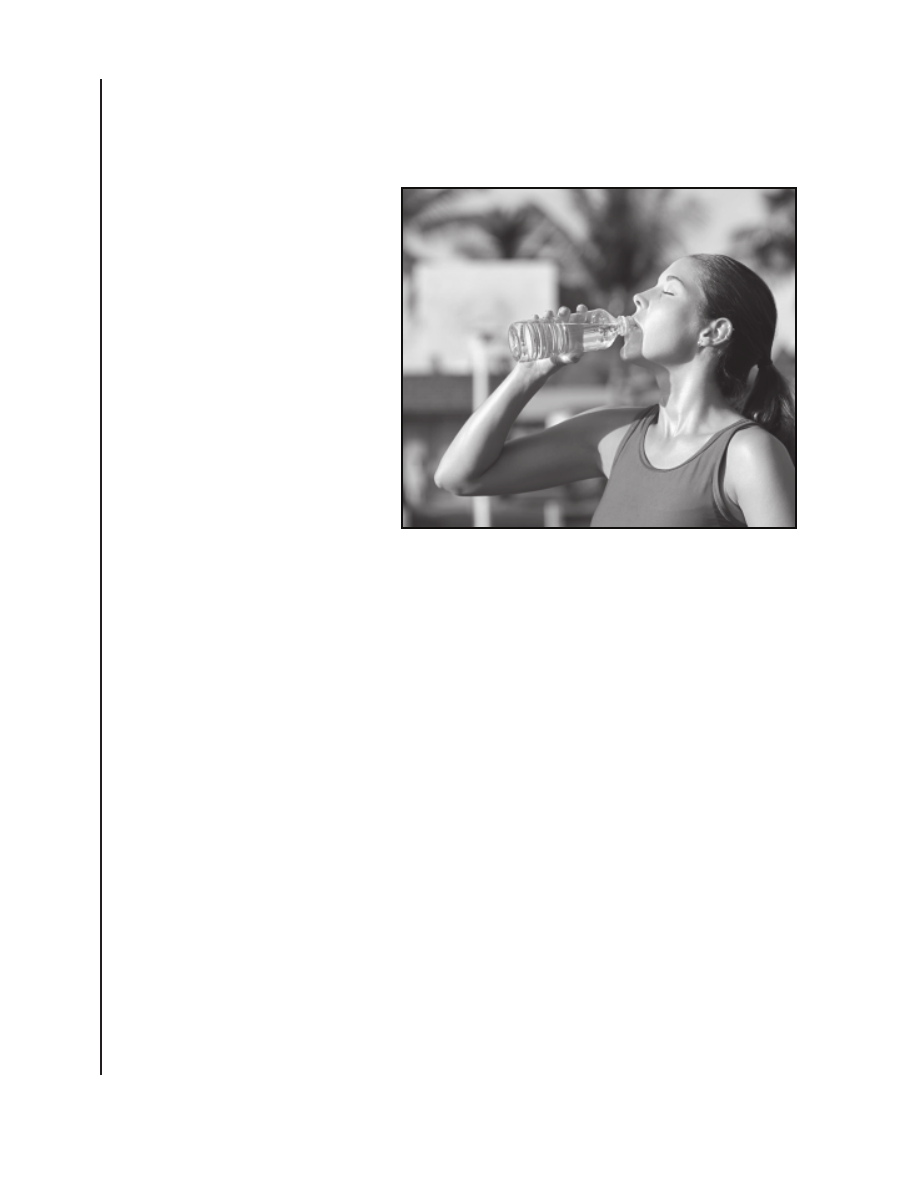ВУЗ: Не указан
Категория: Не указан
Дисциплина: Не указана
Добавлен: 06.12.2020
Просмотров: 1085
Скачиваний: 3

8
Lecture 2: Myths about W
ater and Hydration
However, there’s a cautionary downside to this as well. Aggressively
hydrating, even with sports drinks that contain electrolytes, can actually
worsen the dilution of electrolytes. The only way to really maintain your
osmolality when you’re
drinking that much
À
uid is
to eat salty snacks. When
you push the body to its
limits with extremes of
athletic endurance, you
overwhelm the regulatory
systems. You have to be
careful about how much
you drink, what you drink,
and that you eat.
There are a few questions
that frequently come up
with respect to water.
One is bottled water—
is there an advantage
to it? Interestingly, bottled water costs about 1900 times as much
as tap water. But bottled water, if you look at it statistically,
is no better than tap water. It’s no more healthy, and in
taste tests, it hasn’t been shown to taste any better. Bottled water, overall, is
basically a scam.
What about water puri
¿
ers, which you install in your home to
¿
lter out
organisms, impurities, or heavy metals from your water? Most modern
industrialized countries have agencies, like the Environmental Protection
Agency in the United States, that closely monitor and regulate water.
Currently, there are no major safety issues with tap water in the United
States or other industrialized countries. If you have any concerns, you can
look up these agencies’ reports on the quality of the water in your area. The
legitimate use for water puri
¿
ers is to increase the taste of water. There,
you can just follow your own taste. If your tap water tastes
¿
ne to you, then
don’t worry about it. If it doesn’t taste right, you may want to get a water
puri
¿
er—even though it won’t necessarily be more healthful.
Ŷ
In a warm environment or with physical
exertion, make sure you hydrate continuously.
© Comstock/Thinkstock.
9
Segal, “Body Fluids.”
1.
How does the body maintain its delicate balance of water
and electrolytes?
2.
Are some sources of water better for hydration than others?
Suggested Reading
Questions to Consider

10
Lecture 3: V
itamin and Nutrition Myths
Vitamin and Nutrition Myths
Lecture 3
Even in ancient history, people understood that there was some
connection between nutrition, the food that we eat, and health. For
example, the ancient Egyptians wrote about the fact that liver could
be used to cure night blindness. Although they didn’t understand at
the time that it’s because liver contains vitamin A, they were treating a
vitamin A de
¿
ciency.
O
ne of the most common concerns patients have is about vitamins.
Should they take a multivitamin every day, or can they get all the
nutrition they need from the food they eat? Vitamins are those
nutritional substances that are essential to health in tiny amounts but that an
organism cannot manufacture in suf
¿
cient quantities itself. Therefore, you
have to get vitamins from food.
Vitamins are only part of the nutritional content of food that we need to be
concerned with, the micronutrients. Then there are the macronutrients, those
parts of food from which we get calories or energy and also structural
components, the stuff that we actually build our bodies out of. The three
main types of
macronutrients that
we get in our diet
are carbohydrates,
lipids, and protein.
Food also contains
minerals, including
calcium, phosphorus,
magnesium, iron,
zinc, copper, sodium,
and potassium.
So how do we get
optimal nutrition?
There is general
The best way to get good nutrition is through a well-
balanced, varied diet.
© JupiterImages/Polka Dot/Thinkstock.
11
agreement in the scienti
¿
c community that the best way to get good nutrition
is through a well-balanced, varied diet. You should avoid highly restrictive
or narrow diets that are dependent on just a few different kinds of food. The
USDA food pyramid goes over the rough proportions of different types of
foods that would be contained in a healthful diet. A healthful diet should
contain and should emphasize the following:
Ɣ
You should eat about 2 cups of fruit and 2.5 cups of vegetables
per day. Try to pick from the different subgroups of vegetables,
including dark green vegetables, orange vegetables, legumes, and
starchy vegetables.
Ɣ
You should get 3 or more ounce equivalents of whole grain products
per day, with the rest of your carbohydrates coming from either
enriched or whole grain products.
Ɣ
You should have 3 cups per day of fat-free or low-fat milk or
equivalent milk products.
Ɣ
To round out your diet, you should get protein from lean meats as
well as eggs, nuts, and legumes.
Do we need to take vitamins every day? The big vitamin myth is that taking
a daily vitamin is important for everyone’s health and well-being. In fact,
there is no evidence for any health bene
¿
t of routine supplementation. This
is a very dif
¿
cult question to study, but there have been observational studies
that found no correlation between routinely supplementing with vitamins
and health outcomes. Further, studies that show health advantage or a good
outcome based on nutrition are only able to link those advantages to eating
healthy foods—not to taking supplements.
So far, we have been talking about supplementation for healthy people with no
medical conditions. But what about subpopulations? Children have increased
nutritional needs because they’re growing. Should we routinely give children
vitamin supplements? It’s probably still the best recommendation, based
upon the evidence, that what’s most helpful for growing kids is a healthy
diet. But I know how dif
¿
cult it is to get kids to eat their vegetables. If your
12
Lecture 3: V
itamin and Nutrition Myths
children have a restrictive diet despite your best efforts, it is reasonable to
consider supplementation as nutritional insurance.
Pregnancy is another situation in which there are increased nutritional
demands. It is routinely recommended for pregnancy—and for women who
are planning on possibly becoming
pregnant—to take a prenatal
vitamin because you need to boost
your nutritional reserves before
you know that you are pregnant.
There are also a number of medical
conditions in which our nutritional
needs may be greater than at baseline and where supplementation may be
bene
¿
cial. And there are speci
¿
c conditions or diseases in which there isn’t
a de
¿
ciency, but taking extra vitamins may actually improve symptoms
or outcome.
Vitamins are, by de
¿
nition, essential to nutrition to prevent de
¿
ciencies and
improve many medical outcomes. But I want to emphasize that we need to
avoid the myth that if some vitamins are good, then more must be better. This
has led some to recommend very high doses, sometimes called megadoses, of
vitamins. There is no theoretical reason, nor is there any evidence, to support
the safety or the health effectiveness of megadosing. It is not recommended.
Aside from the possibility of overdosing toxicity, regularly supplementing
with high doses of certain vitamins actually correlates with an increased risk
of certain diseases.
The best advice is to keep it simple: Don’t get overwhelmed with the
complexity of the different types of nutritional advice that people are willing
to give. A few simple rules are enough. Eat a variety of foods; eat plenty
of fruits and vegetables. For most people in most situations, you will be in
perfect health in terms of your nutrition.
Ŷ
The best way to get good
nutrition is through a well-
balanced, varied diet.